Llandyssil is a village in Montgomeryshire, which lies about two miles west-south-west of the county town of Montgomery. The village is situated in beautiful countryside, and the main forms of work were in the agricultural sector. The men of the village who fell during both World Wars are commemorated on a war memorial, in the form of a Celtic Cross, which is situated in the grounds of the Parish Church. The front face of the memorial commemorates thirteen men of the village who fell during the Great War. Three additional names were added to the left-hand face at some time afterwards, then the names of the two men of the village who fell during World War Two were added to the right-hand face.
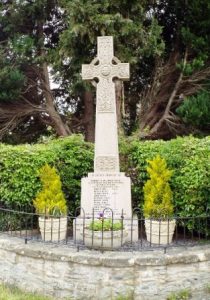
The Great War, 1914-1918
Thomas Bevan, Private, 290897, Royal Welsh Fusiliers. Thomas was born at Bewdley in 1894, the son of William and Elizabeth Bevan. His parents were from Llandyssil, and by 1896 had moved home with their young family, after his father had gained a position as Estate Carpenter in the village. Thomas worked as a Farm Servant at Llandyssil prior to enlisting at Newtown into the 7th Battalion, Royal Welsh Fusiliers on 8 December 1914. The battalion was a Territorial unit, which mobilised for war at Newtown in August 1914, as part of North Wales Brigade, Welsh Division and moved to Conway until the end of the month, before moving to Northampton. In December the Division moved to Cambridge and then in May 1915 to Bedford, where the Division was numbered and the formation became 158 Brigade, 53rd (Welsh) Division. On 19 July 1915 the entire Division sailed from Devonport for Imbros and on 9 August 1915 landed at Suvla Bay. The infantry moved off the beaches into the bush, but due to a lack of maps and no knowledge of the terrain, many of the units became disorientated, and the situation became chaotic. Thomas was evacuated back to Britain from Alexandria aboard the HS Kildonan Castle in December after being wounded at Gallipoli. By 26 February 1916 he had recovered, and embarked at Devonport, re-joining the battalion in Egypt. The Division had been evacuated from Gallipoli in December 1915, moving to Egypt to join the EEF, and helped guard the Suez Canal before taking part in operations to drive the Turks out of the Sinai. The EEF then turned its attention onto driving the Turks out of Palestine, and on 26 March 1917 launched its first offensive against the coastal city of Gaza, which guarded the road to Jerusalem. Initial gains during the day were lost when the assaulting divisions lost touch with each other and communication broke down when a thick fog cloaked the battlefield. Thomas was posted as missing during the fighting that day, and was later confirmed to have been killed in action. The 23-year-old has no known grave and is commemorated on the Jerusalem Memorial, Israel.
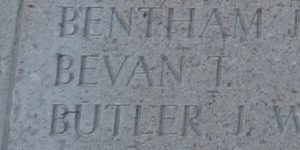
John Eaton, Private, 55197, Royal Welsh Fusiliers. John was the son of Benjamin and Elizabeth Eaton, of Llandyssil. He married Edith Jane Davies on 5 January 1916 and the couple lived at Dingle Cottage, Llandyssil. John had enlisted into the Montgomeryshire Yeomanry prior to the war, but later transferred to the 2nd Battalion, Royal Welsh Fusiliers, joining the battalion in France during the winter of 1916-17. The 2nd RWF was attached to 19 Brigade, 33rd Division, and had suffered heavy casualties during the Somme offensive. The Division spent the first three months of 1917 in the Somme sector, near Suzanne, and followed the German withdrawal to the Hindenburg Line before being transferred to the Arras Sector in April. On 14 April the 2nd RWF moved into the front-line trenches near Henin, facing the Hindenburg Line, to begin a short tour in the line, and three days later the battalion was relieved, moving into support, before officers from the battalion reconnoitred trenches near Croisilles. On 19 April the battalion moved into the Croisilles line, where it prepared to take part in an assault against the Hindenburg Line. On 23 April 1917 two Companies of the 2nd RWF supported an assault by the 4th Suffolk’s against a section of the Hindenburg Line some 300 yards west of the Sensée River. The battalion fought desperately in a section of the line known as Tunnel Trench, suffering heavy casualties throughout the day. John was among over seventy men wounded during the day, and was evacuated to the 20th Casualty Clearing Station, where he died of his wounds on 25 April 1917, aged 25. John is buried in Warlincourt Halte British Cemetery, Saulty, France.
Arthur Bertram Evans, Private, 58408, Royal Welsh Fusiliers. Arthur, known as Bertram, was born in Manchester in 1899, the son of Arthur Evans and Lizzie Evans (nee Mountain). By 1911 the family was living at Oak Shop, Llandyssil. Arthur worked as a Goods Clerk for the Cambrian Railways prior to the war. He enlisted at Welshpool into the Montgomeryshire Yeomanry soon after the outbreak of war. On 5 August 1914 the Montgomeryshire Yeomanry was mobilised at Welshpool, as part of the South Wales Mounted Brigade, before moving via Hereford to Thetford, to join the 1st Mounted Division. On 4 March 1916 the 1st Mounted Division sailed for Egypt to join the EEF. Arthur would have been attached to one of the reserve battalions of the regiment before being drafted to Egypt in the winter of 1916-17 to join the regiment. On 4 March 1917 the battalion merged with the Welsh Horse Yeomanry to form the 25th (Montgomery & Welsh Horse Yeomanry) Battalion, Royal Welsh Fusiliers, as part of the newly formed 231 Brigade, 74th (Yeomanry) Division. The Division assembled in Egypt as part of the EEF, before crossing the Suez Canal into the Sinai, and saw its first major action during the Second Battle of Gaza. The battle was a failure, and the EEF was re-organised under a new commander, Sir Edmund Allenby, before launching the Third Battle of Gaza on the night of 31 October 1917. This assault was launched along a winder front, running from Gaza to Beersheba, and this time the EEF prevailed, opening the door to Jerusalem. Due to the terrible casualties suffered by the British on the Western Front in March and April 1918 the Division was recalled to the Western Front, and arrived at Marseilles during May 1918. The Division trained near Le Cauroy before taking over positions in the St. Floris Sector, moving into the front line between the La Bassée Canal and the River Lys, with the left resting on the small village of Corbie. The Division faced the recently lost town of Merville, some 3,000 yards away. To the south, the Allies launched their offensive on 21 August 1918, and began the great advance towards the Hindenburg Line. The 74th Division was transferred south to join the offensive and assembled around Beaucourt Chateau before moving into the line near the villages of Lempire and Ronssoy. While the 25th RWF was assembling on 17 August, the Germans launched a barrage of gas shells onto their positions, killing three men and gassing almost 60 more. Undeterred, the battalion moved into positions during the night, and at 05.40 on 18 September 1918 took part in an offensive by the 74th Division, against the outer Hindenburg Line defences. Arthur was killed during heavy fighting near Benjamin Post that day. The 19-year-old is buried in Ronssoy Communal Cemetery, France.
George Evans, Private, 291083, Royal Welsh Fusiliers. George was the son of John Evans and Ann Evans (nee Wood), of Watergate, Llanfair. He worked as a Roadman prior to the war and had married Mary Breese at Llandyssil on 16 June 1906. George enlisted into the 7th Battalion, Royal Welsh Fusiliers at Newtown on 10 May 1915. The battalion was a Territorial unit, which mobilised for war at Newtown in August 1914, as part of North Wales Brigade, Welsh Division and moved to Conway until the end of the month, before moving to Northampton. In December the Division moved to Cambridge and then in May 1915 to Bedford, where the Division was numbered and the formation became 158 Brigade, 53rd (Welsh) Division. On 19 July 1915 the entire Division sailed from Devonport for Imbros and on 9 August 1915 landed at Suvla Bay. The infantry moved off the beaches into the bush, but due to a lack of maps and no knowledge of the terrain, many of the units became disorientated, and the situation became chaotic. The Division was eventually evacuated from Gallipoli in December 1915, moving to Egypt to join the EEF, and helped guard the Suez Canal before taking part in operations to drive the Turks out of the Sinai. The EEF then turned its attention onto driving the Turks out of Palestine, and on 26 March 1917 launched its first offensive against the coastal city of Gaza, which guarded the road to Jerusalem. Initial gains during the day were lost when the assaulting divisions lost touch with each other and communication broke down when a thick fog cloaked the battlefield. George was captured by the Turks during the battle, and was taken to a PoW Camp at Bore, near Nigle, Iraq. Prisoners held by the Turks were kept in abysmal conditions, and were often put to work in mines and quarries. George took ill whilst in captivity, and died of dysentery in Iraq at some time between 25 November and 12 December 1918. The official date of his death is recorded as 29 November 1918. The 36-year-old is buried in Baghdad (North Gate) War Cemetery, Iraq. His brother, Walter, died on active service in 1915.
John Ernest Evans, Private, 55278, Royal Welsh Fusiliers. John was the son of Richard and Rosannah Evans, of Oak Cottage, Llandyssil. He worked as a cowman prior to the war. John enlisted at Welshpool into the army and was posted to Kinmel Park for training. John was posted to France during the winter of 1916-17, and joined the 13th Battalion, Royal Welsh Fusiliers, which was attached to 113 Brigade, 38th (Welsh) Division. The Division had taken part in heavy fighting at Mametz Wood in July 1916, and after being relieved, took over a section of the front at Hébuterne before moving to the Ypres Salient, and taking over the Canal Bank sector at Boesinghe. The infantry battalions of the Division then began carrying out the normal pattern of rotation in the trenches, four days in the front, four in support and four in reserve, whilst also working on trench improvement, digging new trenches, and also carrying out regular patrols and trench raids. The 13th RWF had been holding a section of the Canal Bank line before being withdrawn and going into billets at D Camp on 13 April 1917. On 22 April the battalion marched back into the front line, relieving the 15th Welsh, to begin another routine tour in the trenches. This tour was to be a particularly hostile one, with incessant shelling on both sides continuing almost continually until the 13th RWF was relieved on 30 April. John was wounded at some time during this spell in the line. He was evacuated to the 46th Casualty Clearing Station at Proven, where he died of his wounds on 1 May 1917, aged 28. John is buried in Mendinghem Military Cemetery, Belgium.
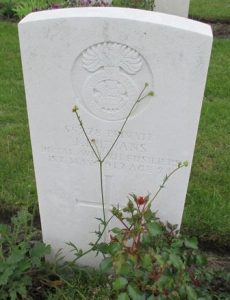
Walter Evans, Private, 1959, Montgomeryshire Yeomanry. Walter was the son of John and Ann Evans (nee Wood), of Watergate, Llanfair. He worked as a Carter at Abercastle prior to the war. Walter enlisted at Caersws into the Montgomeryshire Yeomanry soon after the outbreak of war. On 5 August 1914 the Montgomeryshire Yeomanry was mobilised at Welshpool, as part of the South Wales Mounted Brigade, before moving via Hereford to Thetford, to join the 1st Mounted Division. Walter had only been in Norfolk for a short time before he took ill, and he died at Blything Hospital, Suffolk on 29 December 1915, aged 25. He is buried in St. Edmund’s Churchyard, Southwold. His brother, George, died as a POW in 1918.
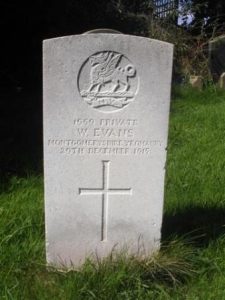
Matthew Sharratt Ford, Corporal, 2595, Australian Machine Gun Corps. Matthew was the son of Alfred Ford, JP, and Fanny Ford (nee Williams), of Ivycot, Abermule. He decided to emigrate to Australia, embarking at London aboard the SS Omrah on 6 December 1912, and disembarked at Melbourne. Matthew then became a sheep shearer at Killarney, Coogee, New South Wales. He enlisted into the Australian Imperial Force at Liverpool, NSW on 16 May 1915, joining the 8th Reinforcements for the 3rd Battalion, AIF, and embarked at Sydney with the unit aboard HMAT Runic on 9 September 1915. The unit disembarked at Alexandria, after their voyage through the Suez Canal, and on 2 November 1915 Matthew was among a number of men sent as drafts to the 3rd Battalion at Gallipoli. The Gallipoli troops were evacuated soon afterwards, and Matthew went back to Alexandria with the 3rd Battalion, and on 12 March 1916 he was posted to the newly formed 1st Brigade Machine Gun Company. On 22 March 1916 his unit embarked for Marseilles, and moved with the 1st Australian Division to the Western Front, to positions near Armentieres. The Division was sent to the Somme in July, and saw heavy fighting at Pozieres and Mouquet Farm. Matthew was hospitalised in October, suffering from Scabies, re-joining his unit two weeks later. The 1st Division followed the German withdrawal to the Hindenburg Line in February 1917 and in April 1917 took part in the Battle of Bullecourt. Matthew was wounded at Bullecourt, being shot in the shoulder, and was evacuated to the 3rd Field Ambulance before being sent to No 3 Stationary Hospital at Rouen. On 20 April he was transferred to England and treated at the 1st Southern General Hospital. He then enjoyed two weeks leave before returning to duty, joining the Australian Depot at Weymouth on 29 May. On 26 June Matthew embarked at Folkestone for France and on 8 July re-joined his battalion in time to take part in the Passchendaele offensive. In February 1918 there was some re-organisation of units in France, and Matthew’s unit became part of the 1st Battalion, Australian Machine Gun Corps, still attached to the 1st Australian Division, which was near Merris, in Flanders. On 9 April 1918 the Germans launched the second phase of their Spring offensive in the area, and the Australians became caught up in desperate fighting near Merris. Matthew was killed in action here on 17 April 1918, aged 27. He is buried in Le Grand Hasard Military Cemetery, Morbecque, France.
Frank Jones, Private, 61311, Royal Welsh Fusiliers. Frank was the son of David and Elizabeth Jones, of Goronddu, Abermule. He worked as a farm labourer at Norton prior to the war. Frank enlisted into the Royal Welsh Fusiliers at Welshpool, and was sent to Kinmel Park for training. Frank was drafted to France early in 1917, and joined the 15th Battalion, Royal Welsh Fusiliers, which was in the Canal Bank sector at Boesinghe, attached to 113 Brigade, 38th (Welsh) Division. The infantry battalions of the Division had been carrying out the normal pattern of rotation in the trenches, four days in the front, four in support and four in reserve, whilst also working on trench improvement, digging new trenches, and also carrying out regular patrols and trench raids. On 31 July 1917 the Division launched its famous assault on the Pilckem Ridge, capturing Iron Cross and reaching its objective of the Steenbeek, then played a supporting role in the Battle of Langemarck. Heavy casualties were suffered by the Division during the initial assault, and the men were mixed up with other units, making the initial casualty role somewhat difficult, so various reports show that Frank was killed in action at some time between 31 July 1917 and 4 August 1917. He is officially commemorated as having been killed on 31 July. The 24-year-old is buried in Artillery Wood Cemetery, Belgium.
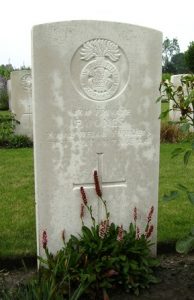
Lumley Owen Williams Jones, DSO, Brigadier General, Essex Regiment. Lumley was born in Cefn-Bryntalch, Llandyssil on 1 December 1876, the youngest son of Richard Edward Jones JP, DL, and Catherine Jones (nee Buckley Williams). He was educated at Clifton and then at Winchester College, and after leaving Winchester was commissioned from the Militia into the 2nd Battalion, Essex Regiment. By 1912 he had been appointed Captain and became the Adjutant to the battalion, and embarked for France with the battalion on 22 August 1914, joining the BEF. He fought through all the earlier actions of the war, and shortly before the Second Battle of Ypres was appointed to the command of the battalion. The battalion performed well during Second Ypres, and was specifically mentioned in Lord French’s Despatches as having twice saved the line. Lumley was afterwards promoted to Brigadier General and placed in charge of the 13th Infantry Brigade, of the 5th Division, which performed well during the Battle of Vimy Ridge. Late in 1917, the Division was ordered to move to Italy and reinforced the Italian front, but had been moved back to France by the time the Germans launched their great Spring offensive of 21 March 1918. Lumley’s Brigade saw much fighting in the ensuing period, and then from 21 August 1918 took part in the great Allied offensive which ultimately won the war. Early in September 1918, Lumley contracted influenza, and his health failed rapidly before he died of pneumonia at Bagneux on 14 September 1918, aged 41. He was buried with full military honours in Bagneux British Cemetery, Gézaincourt, France. Lumley had a conspicuous career, having been awarded the Distinguished Service Order, the French Legion D’Honneur, the Order of St. Maurizio and St. Lazarus, and was seven times mentioned in Despatches. He was the last of twelve British General’s to die during the war. His elder brother, Edward Whitmore Jones, had commanded the 2nd Battalion, South Wales Borderers.
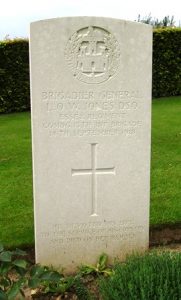
William Joseph Jones, Private, 49834, North Staffordshire Regiment. William was the son of John and Annie Jones, of Green Lane Cottage, Abermule. He had served in the army prior to the war, and as an army reservist was recalled to the colours, re-enlisting at Caersws on 11 October 1915 into the 5th Reserve Cavalry Regiment. William was then placed back onto the army reserve, and was not mobilised until 1 May 1917, when he joined the 5th Reserve Cavalry Depot at Bristol. On 3 September 1917 William was transferred to the 3rd Battalion, North Staffordshire Regiment at Wallsend, and on 17 October 1917 he embarked for France, joining the 9th Battalion, North Staffordshire Regiment, which was attached to the 37th Division, as the Divisional Pioneer battalion. William joined the battalion in the Ypres Salient, where it was based at Vierstraat, supplying working parties at Shrewsbury Forest, Fusilier Wood, Battle Wood and Hollebeke, supporting the Passchendaele offensive. On 10 January 1918 the Division moved out of the Ypres Salient, and moved to billets in various locations north-west of Aire to rest and rebuild, before moving back into the salient at the end of the month, to positions near Dickebusch, and the 9th North Staffs began work in locations at Zillebeke, the Menin Road and at Gheluvelt. The Germans launched their massive Spring offensive to the South on 21 March 1918, along the section of front line running from Croisilles to La Fère, and the Allies crumbled in the face of the onslaught. The 37th Division was rushed south, leaving the salient on 29 March, and entrained at Poperinghe for Doullens. The Division took over a section of front line between Gommecourt and Hébuterne, while the 9th North Staffs took over dugouts at Foncquevillers before beginning work consolidating the new front line. William was with a working party extending a trench line on 10 April when he was shot in the chest and was taken to the 49th Field Ambulance for treatment. He died of his wounds there on 12 April 1918, aged 25. William is buried in Doullens Communal Cemetery Extension No. 1, Somme, France.
George Matthew Mills, Private, 290991, Royal Welsh Fusiliers. George was the son of Frank and Mary Mills, of Brook Cottage, Abermule. He worked as a waggoner at Fronheulog, Llandyssil prior to marrying Mary Elizabeth Richards in 1911, and the couple set up home at Dingle Cottage, Abermule. He then found work as a roadman. George had already served for three years with the Montgomeryshire Yeomanry Territorials when he enlisted into the 7th Battalion, Royal Welsh Fusiliers at Newtown on 8 March 1915. The battalion was also a Territorial unit, which mobilised for war at Newtown in August 1914, as part of North Wales Brigade, Welsh Division and moved to Conway until the end of the month, before moving to Northampton. In December the Division moved to Cambridge and then in May 1915 to Bedford, where the Division was numbered and the formation became 158 Brigade, 53rd (Welsh) Division. On 19 July 1915 the entire Division sailed from Devonport for Imbros and on 9 August 1915 landed at Suvla Bay. The infantry moved off the beaches into the bush, but due to a lack of maps and no knowledge of the terrain, many of the units became disorientated, and the situation became chaotic. The Division was eventually evacuated from Gallipoli in December 1915, moving to Egypt to join the EEF, and helped guard the Suez Canal before taking part in operations to drive the Turks out of the Sinai. The EEF then turned its attention onto driving the Turks out of Palestine, and on 26 March 1917 launched its first offensive against the coastal city of Gaza, which guarded the road to Jerusalem. Initial gains during the day were lost when the assaulting divisions lost touch with each other and communication broke down when a thick fog cloaked the battlefield. George was posted as missing during the fighting of 26 March, but was later officially accepted as having been killed on that date. The 30-year-old has no known grave and is commemorated on the Jerusalem Memorial, Israel.
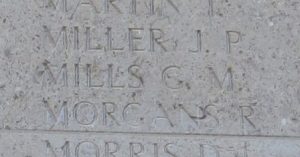
Wilton Stransham Oldham, Captain, Indian Army. Wilton was born in Darjeeling, India on 25 September 1884, the son of William Benjamin Oldham and Maud Julia Oldham (nee Stransham). His father had worked for the East India Company for many years, but had moved back to Britain with his family by 1901. Wilton was educated at Beccles College prior to being commissioned into the Indian Army in March 1905, and by the time war erupted was serving with the 48th Indian Pioneers. The regiment was part of the 6th (Poona) Division and was stationed in Mesopotamia. Wilton was killed near Ctesiphon on 22 November 1915, just prior to his regiment being caught up in the Siege of Kut the following month. The 31-year-old has no known grave and is commemorated on the Basra Memorial, Iraq. His entire regiment was captured when the garrison at Kut surrendered to the Turks on 29 April 1916.
Richard Pearce, Private, 290941, Royal Welsh Fusiliers. Richard was the son of Thomas and Mary Pearce, of Kerry. He worked as a farm servant and lived with his sister Margaret at Top Shop, Llandyssil prior to the war. Richard enlisted into the 7th Battalion, Royal Welsh Fusiliers at Newtown on 14 January 1915. The battalion was a Territorial unit, which mobilised for war at Newtown in August 1914, as part of North Wales Brigade, Welsh Division and moved to Conway until the end of the month, before moving to Northampton. In December the Division moved to Cambridge and then in May 1915 to Bedford, where the Division was numbered and the formation became 158 Brigade, 53rd (Welsh) Division. On 19 July 1915 the entire Division sailed from Devonport for Imbros and on 9 August 1915 landed at Suvla Bay. The infantry moved off the beaches into the bush, but due to a lack of maps and no knowledge of the terrain, many of the units became disorientated, and the situation became chaotic. Richard was killed in action during the fighting that day. The 33-year-old is buried in Gaza War Cemetery, Israel.
John Edward Powell, Gunner, 185408, Royal Garrison Artillery. John was the son of Edward Powell and Frances Ann Powell (nee Morgan), of Oak Cottage, Llandyssil. He enlisted into the Royal Garrison Artillery in Birmingham, and was posted to France in the late summer of 1917, joining the 113th Heavy Battery, RGA. John would probably have seen action during the Third Battle of Ypres later that year. During the Spring of 1918 the Allies suffered terrible casualties, following the launching of three separate German offensives, and after a relatively peaceful mid-summer, launched a massive offensive along the Western Front towards the mighty Hindenburg Line. John was killed in action just over six weeks into the great offensive, on 8 October 1918. The 26-year-old is buried in Guizancourt Farm Cemetery, Gouy, France. His brother-in-law, Charles Joseph Roberts, was killed in 1917.
John Edward Pritchard, Lance Sergeant, 355302, Royal Welsh Fusiliers. John was the son of William and Elizabeth Pritchard of Dingle Cottage, Abermule. He enlisted into the 1/1st Battalion, Montgomeryshire Yeomanry at Welshpool on 28 September 1914. On 5 August 1914 the Montgomeryshire Yeomanry had mobilised at Welshpool, as part of the South Wales Mounted Brigade, before moving via Hereford to Thetford, to join the 1st Mounted Division. On 4 March 1916 the 1st Mounted Division sailed for Egypt to join the EEF. On 4 March 1917 the battalion merged with the Welsh Horse Yeomanry to form the 25th (Montgomery & Welsh Horse Yeomanry) Battalion, Royal Welsh Fusiliers, as part of the newly formed 231 Brigade, 74th (Yeomanry) Division. The Division did not take part in the disastrous First Battle of Gaza, as it was not ready, but took part in the second attempt to take the coastal city, which was launched on 17 April 1917, but also failed, and the EEF suffered a change in leadership, with Sir Edmund Allenby assuming command, before being re-organised, and a third offensive was launched against a wider front from Beersheba to Gaza on 31 October 1917. This time the Turkish defences were breached, and the road to Jerusalem now lay open. John was killed in action during this successful Third Battle of Gaza, on 31 October 1917. The 27-year-old is buried in Beersheba War Cemetery, Israel.
John Walter Woods, Private, 291207, Royal Welsh Fusiliers. John was the son of Joseph and Elizabeth Woods, of Bridge End, Garthmyl. He worked as a farm labourer at Giants Bank, Abermule prior to the war. John enlisted at Newtown into the 3/7th Battalion, Royal Welsh Fusiliers on 15 November 1915 and was posted to Park Hall Camp, Oswestry for training. On 31 May 1916 he embarked at Devonport aboard the HT Kalyan for Egypt and upon disembarking, joined the 1/7th Battalion, Royal Welsh Fusiliers, which was attached to 158 Brigade, 53rd (Welsh) Division. The Division had been evacuated from Gallipoli in December 1915, moving to Egypt to join the EEF, and helped guard the Suez Canal before taking part in operations to drive the Turks out of the Sinai. The EEF then turned its attention onto driving the Turks out of Palestine, and on 26 March 1917 launched its first offensive against the coastal city of Gaza, which guarded the road to Jerusalem. Initial gains during the day were lost when the assaulting divisions lost touch with each other and communication broke down when a thick fog cloaked the battlefield. John was killed in action during the fighting that day. The 22-year-old has no known grave and is commemorated on the Jerusalem Memorial, Israel.
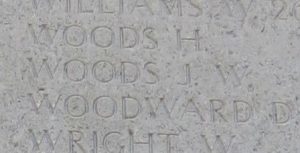
World War Two, 1939-1945
Evan Robert Eaton, Fusilier, 4194192, Royal Welch Fusiliers. Evan was the son of Enoch and Elizabeth Eaton, of Malt House Cottage, Llandyssil. He enlisted into the Royal Welch Fusiliers, and was posted out to Burma. Evan was killed in Burma on 6 April 1943, aged 22. He has no known grave and is commemorated on the Rangoon Memorial, Myanmar.
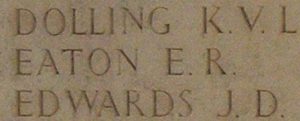
William Thomas Evans, Flying Officer, 165531, Royal Air Force. William was born on 2 May 1924, the son of Abraham Evans and Mary Ann Evans (nee Corfield) of The Hollies, Llandyssil. William enlisted into the Royal Air Force, and after training as a Navigator and Bomb Aimer, was posted to 251 Squadron, RAF, which was based at Reykjavik, Iceland, and was an Air/Sea Rescue and Meteorological unit, equipped with the Lockheed Hudson. On 17 March 1945, William took off from Reykjavik aboard Hudson FK739, which had been detailed to carry out a meteorological reconnaissance in the North Atlantic Ocean. The aircraft remained in contact with base for the early hours of the sortie, but on the return flight shortly after dawn, all communication was lost. Aircraft were despatched to search for the Hudson, but no trace was ever found, and it was presumed lost at sea. William was 20 years old when he lost his life on 17 March 1945. He has no known grave and is commemorated on the Runnymede Memorial, Surrey.